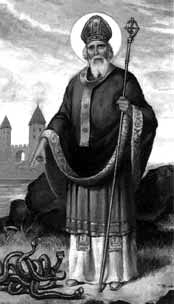It all started with pirates. Around the year 400,
a group of Irish pirates raided a Roman colony in Scotland, kidnapped
a 14-year old boy and made him a slave. The boy, who was named Patricius,
spent the next six years herding sheep for an Irish warlord. He finally
escaped and returned to Scotland, where his father was the Roman governor.
During his captivity, he had religious visions, and this led him to become
a priest. At the age of 46, he was ordained a bishop and sent back to
Ireland to Christianize the island, whose residents at the time were
pagans. Patricius devoted the rest of his life to this task, converting
the wild Irish and building churches. After his death he was canonized
as Saint Patrick, now the patron saint of Ireland.
Saint Patrick inspired many legends. We’ve all heard the one about
his driving the snakes out of Ireland. In fact, today there are no snakes
in Ireland, but there probably never were any, Ireland being separated
from the continent since the end of the last Ice Age. In many pagan religions,
serpent symbols were common and sometimes worshipped. Saint Patrick’s
driving the snakes from Ireland was used metaphorically to symbolize
his ending the practice of paganism.
Saint Patrick’s Day is celebrated with drinking, parades, drinking,
eating, drinking, more drinking, and the “wearing of the green,” symbolized
by the shamrock. According to legend, Saint Patrick chose the shamrock
as the symbol of the Catholic church’s Holy Trinity because of
it’s three leaflets bound by a common stalk.
The date of Saint Patrick’s day, March 17, was the day that Saint
Patrick died, at the age of 74, having changed an entire culture and
the history of the world. Those pirates didn’t know what they were
starting!
Click Here for information on our Ireland Bicycle and Walking Tours.



